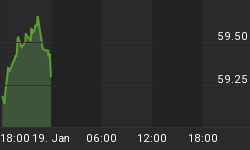Harold Wilson once said that "a week in politics is a long time". Well, that goes double for economies. Last week I said -- against my better judgement -- that the report on US manufacturing by the Institute for Supply Management was painting a rather grim picture that showed manufacturing was contracting.
Today, however, the ISM report for January finds that manufacturing is now expanding with the Performance Manufacturing Index rising from 48.4 per cent in December to 50.7 per cent for January, an increase of 4.8 per cent. Production shot up from 48.6 to 55.2, an increase of 13.6 per cent. Exports rose to 58.5 from 52.5, an increase of 11.4 per cent. The spoiler is that prices jumped from 68 to 76, a whopping rise of 12 per cent. This is definitely not good.
As a rule central bankers are very cautious about lowing interest rates, usually making discrete cuts of 0.25 per cent or 0.5 per cent. The reason for measured approach is that the central bank never really knows by how much rates have to be reduced to get the desired economic response. (In the 1930s Roosevelt's tax, regulatory and industrial policies so crippled industry that it could not even respond to a zero rate of interest). But Bernanke has been the exception to the rule. At the end of January he cut the fed rate by 0.5 per cent, which brought it down to 3 per cent. This came about a week after he slashed the rate by 0.75 per cent. The rate is now at its lowest point since June 2005.
Bernanke's media groupies can call this 1.25 per centage point cut in less than two weeks "brave", "bold" and "necessary" -- I call it panic. It's also probably unprecedented and strongly suggests to me that Bernanke and his pals don't really know what they are doing. For this we can blame their Keynesian 'education'. Writing in 1898 Knut Wicksell pointed out that
[i]t is, however, frequently the case that quite a small fall in the rate of interest would immediately bring about a much greater rise in prices. The price which can be paid for goods obtained by means of credit is higher the longer is the period during which the credit is utilised. (Knut Wickell, Interest and Prices, Sentry Press New York, 1936, pp. 106-107)
In my last article I explained how cutting the interest rate from 4 per cent to 3 per cent could increase industrial demand for loans by up to 33.3 per cent. Well, the Commerce Department recently reported that orders for durable capital goods rose by 5.2 per cent in December. Last August the fed's rate was 5.25 per cent. In September it was cut further to 4.75 per cent. It was then cut to 4.5 per cent in October and then 0.25 per cent to 4.25 per cent in December. We can see that in per centage terms the rate fell by 14.3 per cent from August to October.
All in all, from last August to last January the rate fell by a massive 43 per cent. It's possible that the earlier cuts are what fuelled the recent uplift in manufacturing. If so then it is just as likely that they are responsible for the sudden increase in manufacturing costs. So long as 'cheap' credit is made available and output prices stay head of costs then the expansion will continue. But this also means more inflation and further pressure on the dollar. Whether Bernanke's aggressive monetary expansion aggravates the current account will be determined by how it affects exchange rate. It's not the stimulus that should be scrutinised but the Fed's monkeying around with interest rates.
I've felt for sometime that the US economy had a lot more steam in it than it was given credit for. Unfortunately, Bernanke has decided to turn it into a pressure cooker. How long this can go on for is anyone's guess at this time. It bears thinking about that the Reserve Bank of Australia did the same thing in 2000 and generated a boom that only now appears to be reaching its end.
I'm forever saying that whenever there is a recession or a financial crisis the market always gets the blame. Well, here we go again. Irwin M. Stelzer states that the "sub-prime fiasco has revealed an important market failure". (The Old Order Changeth: Fallout from the sub-prime fiasco, National Review on Line, 29 January 2008). It never occurs to the likes of Stelzer that this "fiasco" was created by Congress and the Fed, thus making it a clear case of government failure. Congress put pressure on financial intermediaries to provide mortgages for bad risks. The Fed then supplied oodles of credit to fund, among other things, these mortgages. Is this so difficult to grasp?
Unfortunately, inflation -- which is what credit expansion is about -- is also a moral hazard that seems to have a corrosive effect on ethics that few appear able to resist. It is no accident, in my opinion, that inflationary periods tend to be marked by financial scandals. Once again the market is blamed, being accused of fostering selfishness and greed when in fact the real culprit is unbelievably bad economics. In addition, few moralising critics of so-called 'market failure' and 'cupidity' ever condemn political greed and corruption.















